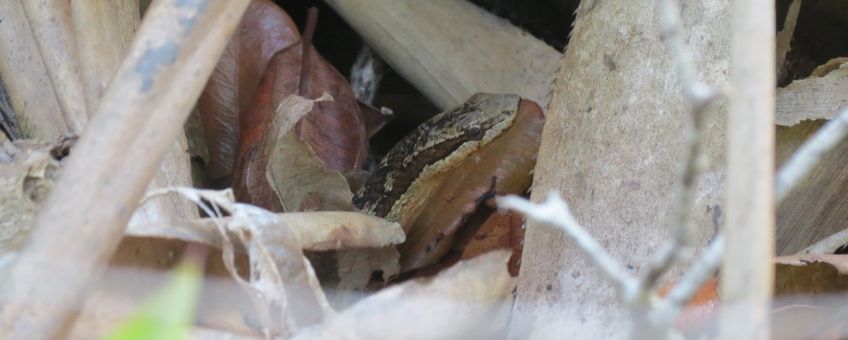
Status of the red-bellied racer on Saba and St. Eustatius
Caribbean Netherlands Science Institute, Dutch Caribbean Nature Alliance (DCNA), Saba Conservation Foundation (SCF)On Saba and St. Eustatius, the red-bellied racer (Alsophis rufiventris) plays a key role in the islands’ ecosystems by regulating small reptile and amphibian populations. Anoles, especially the endemic and highly abundant Anolis sabanus on Saba, and whistling frogs (Eleutherodactylus johnstonei) form an important food source for racers.
 Despite the presence of invasive species such as black rats (Rattus rattus) and domestic cats (Felis catus), racer populations on Saba and St. Eustatius were previously described as “robust” and “abundant”, and were considered stable. For that reason, the species was downgraded from Endangered to Vulnerable by the International Union for the Conservation of Nature in 2016. However, in September 2017, category 5 hurricanes Irma and Maria caused extensive damage to the natural ecosystems on both islands, resulting in habitat loss, reduced prey abundance and increased racer mortality, which raised concerns for the conservation status of this species.
Despite the presence of invasive species such as black rats (Rattus rattus) and domestic cats (Felis catus), racer populations on Saba and St. Eustatius were previously described as “robust” and “abundant”, and were considered stable. For that reason, the species was downgraded from Endangered to Vulnerable by the International Union for the Conservation of Nature in 2016. However, in September 2017, category 5 hurricanes Irma and Maria caused extensive damage to the natural ecosystems on both islands, resulting in habitat loss, reduced prey abundance and increased racer mortality, which raised concerns for the conservation status of this species.
In 2011, a group of students from the University of Puerto Rico visited St. Eustatius for one week. They conducted some racer surveys in the Quill and Boven National Parks. In 2018 and 2019, RAVON interns Kevin Verdel and Brent Kaboord conducted extensive surveys in the parks to monitor racer populations following hurricane impacts. Until this year, however, no quantitative data had been collected on Saba. Between July and September 2021, Hannah Madden from the Caribbean Netherlands Science Institute and volunteer Lara Mielke joined forces to conduct racer surveys on Saba. Replicating the methods used on St. Eustatius allowed us to compare the results from both islands and create a baseline for future research and conservation efforts.
 In cooperation with the Saba Conservation Foundation, Lara Mielke conducted line transect surveys along existing hiking trails.These covered six different vegetation types and a range of elevations, from 100m to the top of Mount Scenery (870m). Occupancy modelling revealed that racers were present in all vegetation types and were more likely to be present at elevations over 400m. Distance analysis revealed a density estimate of 10.9 racers/hectare on Saba, which across the entire survey region (438.6 ha) gives an estimate of 4,917 racers. These results are similar to those from St. Eustatius, where racers were present in all vegetation types surveyed and mean abundance increased in line with elevation. However, density estimates from St. Eustatius were lower (9.9/ha in 2018 and 7.3 in 2019), with a population estimate of 3,915 racers across the study region (540 ha) in 2019. This suggests that the racer population on Saba is healthier than the one on St. Eustatius, but this may be due to the fact that surveys on Saba were conducted later, giving the population more time to recover.
In cooperation with the Saba Conservation Foundation, Lara Mielke conducted line transect surveys along existing hiking trails.These covered six different vegetation types and a range of elevations, from 100m to the top of Mount Scenery (870m). Occupancy modelling revealed that racers were present in all vegetation types and were more likely to be present at elevations over 400m. Distance analysis revealed a density estimate of 10.9 racers/hectare on Saba, which across the entire survey region (438.6 ha) gives an estimate of 4,917 racers. These results are similar to those from St. Eustatius, where racers were present in all vegetation types surveyed and mean abundance increased in line with elevation. However, density estimates from St. Eustatius were lower (9.9/ha in 2018 and 7.3 in 2019), with a population estimate of 3,915 racers across the study region (540 ha) in 2019. This suggests that the racer population on Saba is healthier than the one on St. Eustatius, but this may be due to the fact that surveys on Saba were conducted later, giving the population more time to recover.
Unfortunately, few detailed studies exist on the ideal pre-hurricane density of red-bellied racers. However, a 2016 study from Guana Island, British Virgin Islands, on the Puerto Rican Racer estimated 19/ha. While racer densities are likely to be species- and habitat-specific, based on literature describing pre-hurricane populations on Saba and St. Eustatius as “thriving”, it is highly likely that these suffered significant declines as a result of the hurricanes. The encounter rate of racers from St. Eustatius based on fieldwork in 2011 was estimated at 16/hour, which dropped to just 0.41/hour in 2019. On Saba, the current encounter rate estimate is 1.28/hour, thus while the species may have recovered since 2017, it is unlikely to be close to pre-hurricane levels.

Besides hurricanes, racer populations face a suite of additional threats on both islands, including ongoing habitat destruction and predation by invasive species. We are extremely concerned about the impacts of free-roaming domestic cats on racers, which appear to be especially pervasive on Saba. Saba residents continue to import pet cats from St. Maarten, despite this being prohibited by a local invasive species ordinance. Consequently, enforcement of legislation and prevention of local extinction should be a top conservation priority on both islands, especially given the species’ extremely limited range.
Text: Dutch Caribbean Nature Alliance
Photos: Lara Mielke; Bart Noort
